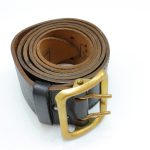Step-by-Step Guide: Safely Lowering Your Triumph Tiger Sport 660 for Optimal Comfort
Understanding the Need for Lowering Your Motorcycle
Before we dive into the nitty-gritty of lowering your Triumph Tiger Sport 660, it’s essential to understand why you might want to do this in the first place. For many riders, especially those with shorter statures, the standard ride height of the Tiger Sport 660 can be a bit intimidating. The bike’s seat height of 835mm can make it difficult to touch the ground comfortably, which can affect the overall riding experience and safety.
“As a rider, having a bike that fits you well is crucial for both comfort and safety,” says John, a seasoned motorcyclist. “When you can’t put both feet flat on the ground, it can be nerve-wracking, especially at low speeds or when stopping.”
Also to see : Step-by-Step Guide to Safely Remove and Replace the Alternator on Your Triumph Tiger 1200
Choosing the Right Lowering Kit
When it comes to lowering your Triumph Tiger Sport 660, you need to select a high-quality lowering kit that is specifically designed for your bike. Here are some key points to consider:
Compatibility
Ensure the kit is compatible with your bike’s model and year. For the Triumph Tiger Sport 660, you should look for kits that are explicitly designed for this model.
Also to read : Unlocking Speed: Ideal Gear Ratios for Circuit Racing with the Ducati 959 Panigale
Materials and Construction
Opt for kits made from high-quality materials that can withstand the rigors of regular use. Look for kits with durable components and a robust design.
Ease of Installation
Choose a kit that is relatively easy to install. Some kits come with detailed instructions and require minimal tools, making the process less daunting.
Impact on Performance
Understand how the lowering kit will affect your bike’s performance. A good kit should not compromise the bike’s suspension travel or handling.
Here is a detailed list of what to look for in a lowering kit:
- Compatibility: Ensure the kit is designed for the Triumph Tiger Sport 660.
- Materials: High-quality materials such as steel or aluminum.
- Ease of Installation: Detailed instructions and minimal tools required.
- Performance Impact: No significant compromise on suspension travel or handling.
- Warranty: Look for kits with a good warranty to cover any defects.
- Customer Reviews: Check reviews from other users to gauge the kit’s effectiveness and any potential issues.
Preparing Your Bike for Lowering
Before you start the lowering process, there are several steps you need to follow to ensure everything goes smoothly and safely.
Read the Manual
Familiarize yourself with the owner handbook and the manual pages specific to the lowering kit you’ve chosen. Understanding the instructions and any specific recommendations is crucial.
Gather Tools and Materials
Make sure you have all the necessary tools and materials as specified in the manual. This includes any specialized tools that might be required.
Check the Oil Level
Ensure the engine oil level is at the recommended level. This is important to avoid any damage to the engine during the process.
Prepare a Safe Workspace
Choose a flat, level surface and ensure the area is clear of any obstacles. Use a center stand or paddock stand to lift the bike, making it easier to work underneath.
Here’s a checklist to prepare your bike:
- Read the Manual: Understand the instructions and recommendations.
- Gather Tools and Materials: Ensure you have everything needed.
- Check the Oil Level: Maintain the recommended engine oil level.
- Prepare a Safe Workspace: Use a center stand or paddock stand and clear the area.
Step-by-Step Lowering Process
Lowering your Triumph Tiger Sport 660 involves several key steps. Here’s a detailed guide to follow:
Step 1: Remove the Rear Shock
Start by removing the rear shock absorber. This will give you access to the components that need to be adjusted or replaced. Use the manual to locate the bolts and follow the instructions for removal.
Step 2: Install the Lowering Links
Install the lowering links provided with the kit. These links will adjust the rear suspension to lower the bike. Follow the manual for specific instructions on how to attach these links.
Step 3: Adjust the Front Suspension
If your kit includes adjustments for the front suspension, follow the instructions to lower the front forks. This may involve removing spacers or adjusting the fork travel.
Step 4: Reinstall the Rear Shock
Once the lowering links are installed, reinstall the rear shock absorber. Ensure all bolts are tightened to the specified torque settings.
Step 5: Test the Bike
Take the bike for a test ride to ensure everything is working correctly and the ride height feels comfortable.
Here is a detailed list of the steps involved:
- Step 1: Remove the Rear Shock: Access the rear suspension components.
- Use the manual to locate the bolts.
- Follow instructions for removal.
- Step 2: Install the Lowering Links: Adjust the rear suspension.
- Follow the manual for specific instructions.
- Ensure all bolts are tightened correctly.
- Step 3: Adjust the Front Suspension: Lower the front forks if necessary.
- Remove spacers or adjust fork travel as per instructions.
- Step 4: Reinstall the Rear Shock: Put back the rear shock absorber.
- Ensure all bolts are tightened to specified torque settings.
- Step 5: Test the Bike: Take a test ride to ensure comfort and performance.
Impact on Performance and Specifications
Lowering your Triumph Tiger Sport 660 can have some effects on its performance and specifications. Here’s what you need to know:
Suspension Travel
Lowering the bike reduces the suspension travel, which can affect handling, especially over rough terrain. However, a good lowering kit is designed to minimize this impact.
Ground Clearance
The ground clearance will be reduced, which can increase the risk of scraping the underside of the bike on steep inclines or rough roads.
Handling
The handling of the bike may be slightly affected due to the changed geometry. However, this is usually minimal if the kit is well-designed.
Here is a comparative table showing the key specifications before and after lowering:
| Specification | Standard | Lowered |
|---|---|---|
| Seat Height | 835mm | 795mm |
| Suspension Travel | 150mm | 120mm |
| Ground Clearance | 170mm | 140mm |
| Handling | Unaffected | Slightly affected |
Practical Insights and Actionable Advice
Here are some practical tips to keep in mind when lowering your Triumph Tiger Sport 660:
Follow the Manual
Always follow the instructions provided with the lowering kit. These manuals are designed to ensure the process is safe and effective.
Check the Ride Height
After lowering the bike, ensure the ride height feels comfortable for you. You should be able to put both feet flat on the ground.
Test Thoroughly
Take the bike for a thorough test ride to ensure everything is working as expected. Check for any unusual noises or vibrations.
Maintain Regularly
Regular maintenance is crucial to ensure the bike continues to perform optimally. Check the oil level regularly and follow the recommended service intervals.
Lowering your Triumph Tiger Sport 660 can significantly enhance your riding experience by making the bike more accessible and comfortable. However, it’s crucial to follow the steps carefully and choose a high-quality lowering kit to avoid any compromise on performance.
“Lowering my Tiger Sport 660 has made a world of difference,” says Sarah, a rider who recently made the adjustment. “I feel more confident and comfortable on the bike now.”
By following this step-by-step guide, you can safely lower your Triumph Tiger Sport 660 and enjoy an optimal riding experience. Remember to always prioritize safety and performance, and don’t hesitate to seek professional help if you’re unsure about any part of the process.











